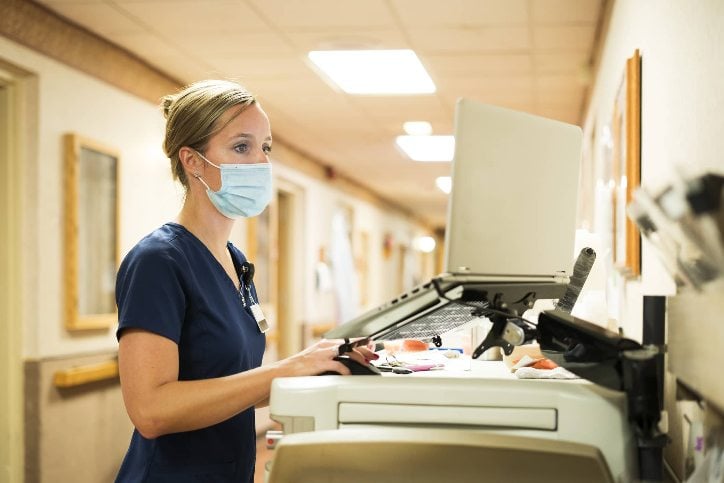
Advances in Nursing Technology Revolutionizing Patient Care
"Technology is adopted by society in stages. Initially, technology does work that was previously done by people. That is, technology simply replaces a manual method of doing some activity. As technology allows work to be accomplished that previously was not possible, true innovation occurs. Finally, adoption becomes so complete that all dimensions of society itself are transformed by the technology."
– C. Delaney, Computer Technology, "Current Issues in Nursing" (1989)
Technology is booming in all sectors of the workforce and the field of nursing is no exception. Nurses today are discovering that they have access to advanced devices and software, thereby making their jobs easier and faster. The result is increased efficiency with day-to-day tasks and in how nurses provide patient care.
AMN Healthcare looks at one of the most popular devices on the market today used by nurses--personal digital assistants (PDAs).
Instead of carrying manuals with procedures or references or index cards with patient information in their pockets, with the use of PDAs nurses can immediately enter patient information at the bedside and later upload it into a personal computer. Many believe this will not only increase efficiency, but will also help to reduce medication errors and reduce costs.
Tools of The Trade
Many nurses are using PDAs to write prescriptions, to perform charge capture, vital capture, order entry, dictation and to look up reference materials.
Peter Geerlofs, chief medical officer at Allscripts, an e-healthcare solutions company, said, "Clinical information is growing at a rate where it is impossible for any clinician to keep up. Information systems are becoming ever more essential to practicing quality medicine. PDAs make it possible to take that information with you wherever you go. That’s transformative."
Allscripts positions itself as the leading provider of point-of-care decision support solutions for health care professionals, and markets the Allscripts Pocket Library™, a clinical resource available for PDA devices, in both a stand-alone format and as part of its overall clinical solution, TouchWorks™, a suite of tools including e-prescribing, dictation and charge, all running on the Microsoft Pocket PC operating system.
Geerlofs also said that nurses have most likely been slow to adopt clinical information systems in the past because of the relative expense and complexity of the technology.
"I believe that physicians and nurses are not necessarily technology phobic as a group--but busy professionals typically adopt new tools only when they meet perceived needs," he said. He also added that, with the advent of newer, more affordable PDA-based tools, health care professionals are quickly adapting to using the devices.
Reducing Medical Errors
One PDA user, Christy Flory, RN, BSN, MS, who is an adult nurse practitioner in dermatology at Beth Israel Deaconess Medical Center in Boston, Massachusetts, said that the device and the software (qRx and QID) developed by ePocrates, another software solutions company, "has kept my blood pressure down," she said. "I can pull the PalmPilot out of my pocket, tap a few things and get an answer. It’s much easier than sitting down at a computer and looking things up."
T.J. Haymans-Benedict, RN, BSN, who works in critical care, med-surg and the emergency room at Memorial Health System in Savannah, Georgia, agreed.
"I use the Palm [Pilot] daily to keep up with medications and interactions," she said.
In fact, the Institute of Medicine’s November 1999 report found that the use of PDAs can reduce medication errors by 50 percent, cutting the number of errors caused by illegible handwriting, unreadable carbon copies and order sheets stamped with the wrong patient’s name.
Build It and They Will Come
While much of the software and the operating systems that run the application software on the hand-held devices is being created by large corporations such as Allscripts, 3Com (makers of PalmPilot), Microsoft and others, nurses are using their critical thinking skills and computer savvy to create software built "for nurses by nurses" to specifically meet the on-the-job needs of nurses.
Lynette Jones, RN, Ph.D., chairwoman of the board of Point of CareWare in Bellevue, Washington, develops software programs for use on hand-held computers and PCs.
After working in health care for more than 20 years, including insurance companies, government agencies and clinical venues such as intensive care units and post-acute care, Jones found that all of these places had common technological needs.
"I went into the Ph.D. program [at the University of Washington] with intent to start building the ultimate technology to meet the problems that were lacking in the places where I was employed," she said.
Combining epidemiology and bio-statistics with her doctorate health services research, Jones formulated a system that would assist clinicians, agencies, consumers and families. In 1996, two years after earning her advanced degree, Jones turned the project into Point of CareWare, a company focused on nurses, providing business solutions via an Internet browser--specifically targeted to skilled nursing facilities, intermediate care, rehabilitation, assisted living and community retirement facilities.
Jones isn’t the only nurse jumping on this ever-evolving technology bandwagon.
Jeneane A. Brian, RN, BSN, MBA, president and corporate executive officer for VNA Home Health Services (VNAHHS) in Santa Ana, California, wanted to find a way to retain nurses--especially with the growing nursing shortage.
Looking back over her own nursing experience, she thought about what nurses liked the least about their jobs. "Certainly the usual suspects came up: pay and hours," she said, "but it looked like I could play a big part in keeping people in [nursing] by cutting paperwork--especially nurses in the home care industry."
According to Brian, for every hour of nursing care given, there’s 30 minutes of paperwork in a hospital setting, whereas in home health care for every one hour of nursing there’s 48 minutes of paperwork, which can amount to three hours of paperwork, not including calls and travel time--most of which is done on nurses’ personal time.
Pulling together a team of volunteers, including nurses, Brian set out to create a custom Palm OS software solution for homecare. Starting with the forms used by nurses in the high-risk infant program at VNAHHS--because the forms were simpler than those for Medi-Care patients--the forms were immediately adopted by the nurses in the unit.
"The paper forms are gone and the nurses won’t go back to paper," said Brian, who noted that paperwork has been reduced by 50 percent at VNAHHS.
"[The handheld device] has made an enormous improvement in morale," said Brian. "Though they can’t replace the computer and they can’t fix management problems, they give [home care] nurses back their personal lives."
Implementing PDAs in the Workplace
While certain software could be the answer nurses are looking for, it must also be user-friendly and necessary.
"Create software nurses want to use, but don’t punish them with it," Brian said. "It will fail and it’s the wrong agenda, which is a waste of time and money. It must be an improvement in a nurse’s day."
While she makes building and implementing software look easy, that is not always the case as many health care facilities face budgeting issues and other concerns.
Leah Curtain, RN, ScD(h), FAAN, editor-in-chief of "Curtain Calls," for Health Management Technology magazine, advises nurses interested in participating in the information technology decision-making or with other issues should "understand the full impact of all modifications to all systems--administrative and financial systems as well as nursing/clinical systems. Financial and administrative system changes often have significant impact on nursing, a fact often overlooked by those who are not involved in the day-to-day use/implementation of IT changes."
PDAs in Nursing Schools
While many nurses are taking advantage of PDAs, there are still those nurses who can’t seem to put their fears and phobias of technology aside. Jones pointed out that much of these fears will need to be put to rest by nursing schools.
"Nursing education needs to accommodate, accept and embrace technology, while nurses need to learn critical thinking and technical skills to analyze data," she said. "There are not enough nurses to continue to provide one-on-one care, which nursing has focused on for so long. Nursing needs to embrace the tools and the benefits of information technology otherwise nurses are not going to meet the care demand."
The University of Virginia School of Nursing recently became the first school of nursing to require students to use hand-held devices. Introduced by Arlene Keeling, RN, Ph.D., Audrey Snyder, RN, MSN, ACNP, and Suzanne Burns, RN, MSN, they wanted to bring nursing education into the 21st century. Recognizing that the paperbound books used by nursing students would soon be outdated and obsolete, they looked to PDAs as a tool of the future that would provide students the necessary skills and information technology to compete in today’s ever-changing health care environment.
"Nurses must have the tools to provide more efficient care," said Jones. "This is particularly important with the nursing shortage."
What Does the Future Hold?
The growth in use of hand-held devices by nurses and other clinicians is expected to rise, especially as the PDAs increase in memory capacity, gain the ability to add attachments such as digital cameras and scanning devices, and offer add-ons and multifunctional devices allowing the PDA user to toggle between different software programs and appliances.
"PDAs will evolve just as PCs have," said Brian, who uses her Palm as a computer, a phone and for connecting to the Internet. "And as they grow, caring for patients will become easier in a mobile environment."
According to Geerlofs, Allscripts believes that increasingly sophisticated decision support and knowledge-coupling will become an indispensable part of the nursing practice.
"This means clinical information systems [would] understand the context of the problem being addressed for a particular patient, and [then deliver] any information necessary to make consistent, evidence-based decisions," he said. "Our next generation of ambulatory care tools include all of the ordering functions as well--so that the burdensome and time-consuming administrative aspects of care can be greatly reduced."
© 2016. AMN Healthcare, Inc. All Rights Reserved.



